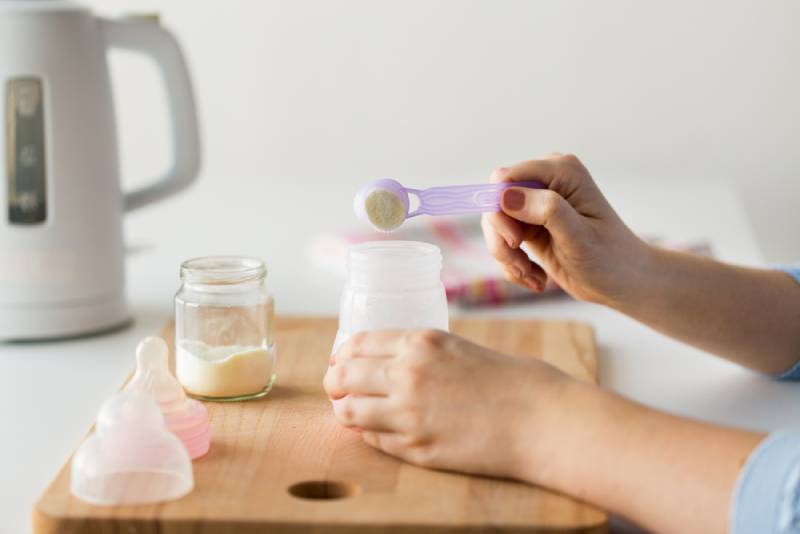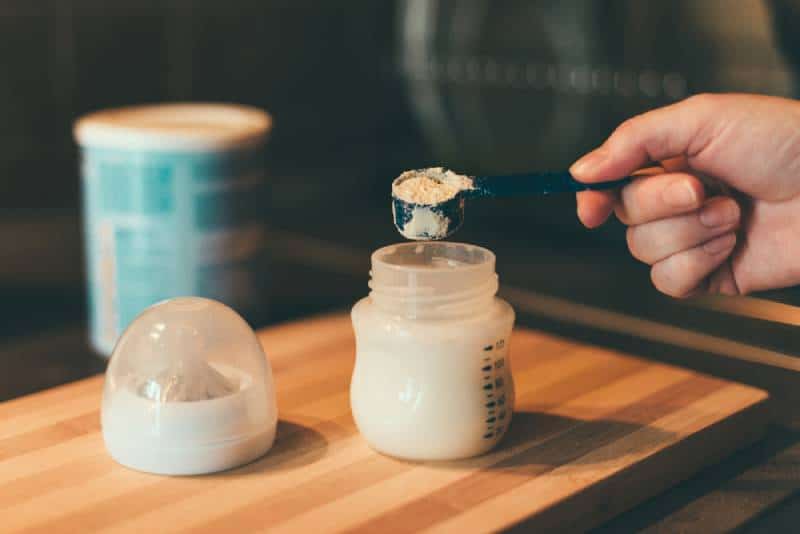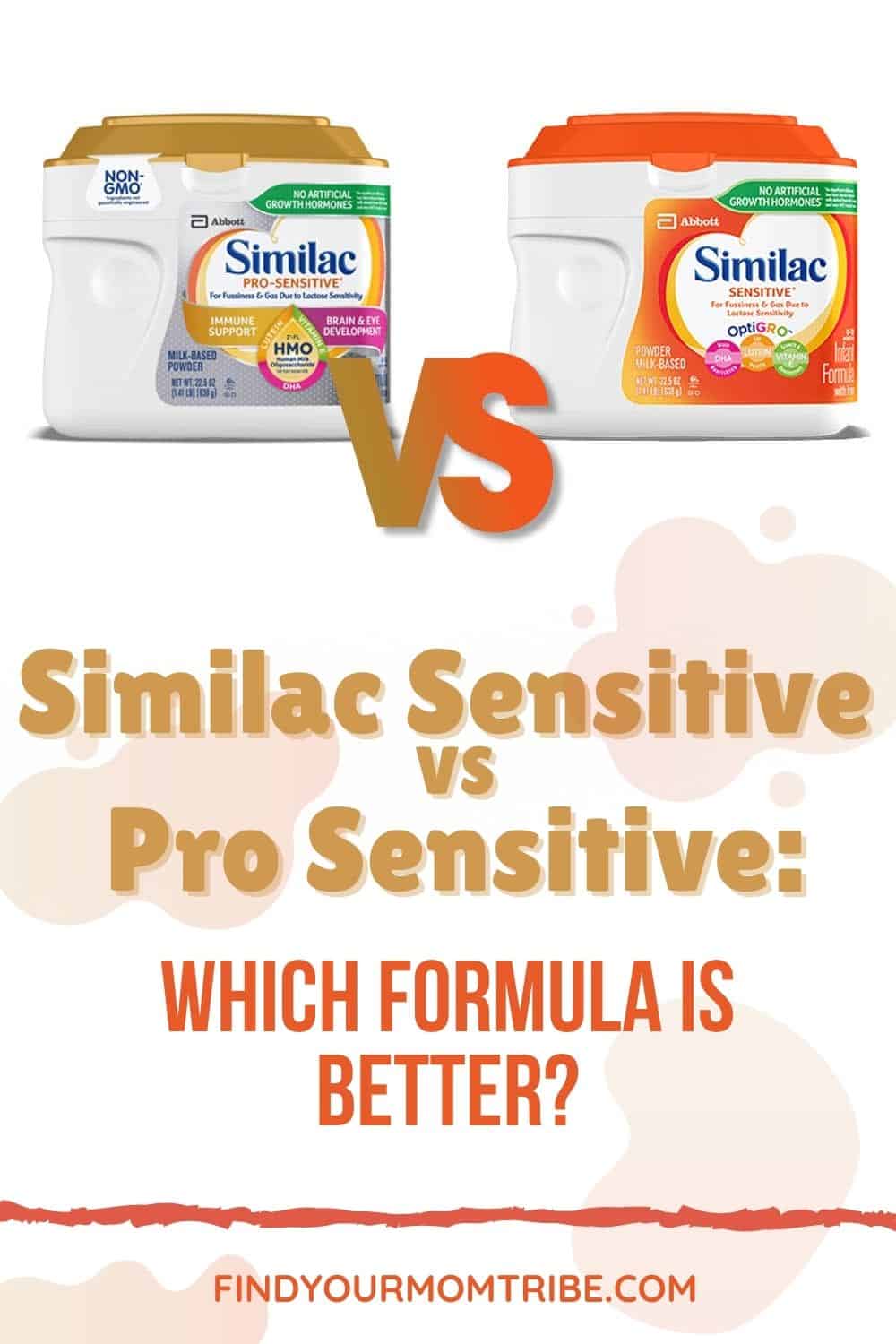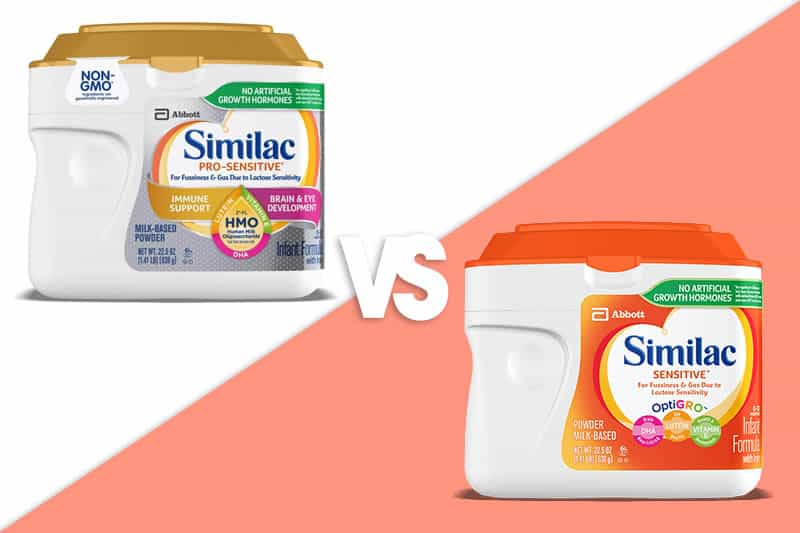When it comes to Similac Sensitive vs Pro Sensitive infant formula, it can be hard to see which one is the best for your baby since they are quite similar, although differences do exist. But what are these differences?
For one, Similac Pro Sensitive contains 2′-FL HMO, an important nutrient found in breast milk that is key for the healthy development of a baby’s immune system and helps soothe cranky babies. Plus, it’s GMO-free.
There are some less-obvious differences that you can’t tell just by looking at the package.
One of them is that the regular Sensitive formula tends to bubble and foam more, which can be troublesome for parents of already gassy babies.
But the two formula products also have numerous similarities that make them a great choice for babies with delicate tummies who are sensitive to the lactose found in many infant formula brands.
With that being said, let’s take a look at how the two formulas compare across different factors so that you can save yourself some precious time.
Similac Sensitive vs Pro Sensitive: Key differences

When comparing Similac Sensitive vs. Pro Sensitive, it’s important to remember that both infant formulas come from the same company, meaning that their differences won’t be drastic.
Still, formula-fed babies deserve only the absolute best when it comes to their nutrition, which is why you should know how both baby formulas compare in terms of ingredients, cost, taste, and so on.
2′-FL HMO (2′-Fucosyllactose Human Milk Oligosaccharide)

The first significant difference between these two formulas is that Similac Pro Sensitive contains 2′-FL HMO while Similar Sensitive does not.
Since 2’-FL Human Milk Oligosaccharide is a rather complex ingredient, let’s break it down to see why it’s so important for your little one.
HMO is a prebiotic that occurs naturally in the mother’s breast milk and it’s responsible for developing the baby’s immune system and probiotics in the gastrointestinal system.
As such, adding it to baby formula is a significant step towards making formula as similar to breast milk as possible.
Even though the 2′-FL HMO in Similac Pro Sensitive does not come directly from human milk, it is the same as the “original” and is perfectly healthy for your baby.
A 2018 scientific study has also confirmed that adding this ingredient brings many benefits to babies, over and above providing immune support.
For example, babies who were fed this type of formula were found to not have as many respiratory infections according to their parents. In addition, it was well tolerated in terms of reducing fussiness and didn’t cause tummy trouble.
Foam

A gassy baby is a very unhappy baby and the kind of formula you use can have a big impact on your little one’s digestive system.
When a formula foams, that means it’s filled with air that will travel down to your baby’s stomach where it’s going to cause gas.
That’s why many parents who are experienced with baby formula tend to avoid brands that foam too much, especially if their baby already has a sensitive tummy.
While special baby formulas for reflux can help, in addition to popular remedies such as gripe water, sometimes the key is in finding a formula that doesn’t create too much foam.
That being said, parents report that the Sensitive formula tends to foam more than the Pro Sensitive one and the bubbles can be quite difficult to get rid of.
Even though not all parents have had this problem and some have found ways of mixing it to avoid foam, it is something important to note.
Although, if you purchase a ready to feed bottle, then this will not be a problem.
Non-GMO

Whether or not a baby formula contains artificial growth hormones can make it or break it for some parents who want to avoid them at all costs.
Thankfully, many infant formula brands have been paying attention and produced formulas that are free from GMOs.
When it comes to Similac Sensitive vs Pro Sensitive, you will be happy to know that Similac Pro Sensitive does not contain artificial growth hormones.
If you would like to go an extra step further in choosing the healthiest formula for your baby, you can opt for organic brands that are also non-GMO.
On the other hand, you should know that even though non-GMO foods and formula are preferred by a growing number of parents, baby formula that contains GMOs is still perfectly safe to drink.
In addition, there have been no significant differences shown between milk from non-RBST-treated and RBST-treated cows.
Price

Since Similac is one of the best-known formula brands out there, it’s expected that it will be more expensive than the generic formulas.
However, there are differences in cost between various formula lines that Similac sells.
Between these two formulas, Similac Sensitive is more affordable than Pro Sensitive.
Because the latter includes beneficial ingredients such as 2’-FL Human Milk Oligosaccharide and is GMO-free, the higher price point is justified.
In addition, it doesn’t produce as many bubbles as that of Sensitive.
Taste

The taste of a particular formula brand is difficult to rate because it depends on the baby’s preferences.
Some infants might enjoy a particular formula, while others will downright refuse it.
Still, parents have reported that the regular Sensitive formula has a strong taste that not all babies might like.
On the other hand, the Similac Pro Sensitive seems to be a bit sweeter and more pleasant, so the majority of babies will definitely enjoy it.
However, I wouldn’t consider taste to be the most defining factor when it comes to Similac Sensitive vs Pro Sensitive, since this is something that your baby will ultimately decide – and as all mamas can attest to, babies can be quite unpredictable!
Similac Sensitive vs Pro Sensitive: Key similarities

Now that I’ve told you all about the differences between Similac Sensitive and Pro Sensitive, it’s time to tackle their similarities.
In fact, these two formulas have a lot in common, especially when it comes to their ingredients.
Not made for babies with galactosemia
Galactosemia is a medical condition that prevents the body from properly digesting galactose, which is a kind of sugar found in baby formula and breast milk.
This is a condition passed from parent to baby and it can be extremely dangerous if left untreated.
Neither the Sensitive nor Pro Sensitive formulas were made for babies with galactosemia.
If your pediatrician diagnoses your baby with this condition, he or she will give you all the information you need on the appropriate diet.
OptiGRO ingredients

Marketed as an exclusive blend of DHA and nutrients such as vitamin E and lutein, both Sensitive and Pro Sensitive contain Similac’s OptiGRO ingredients.
Considering that formula will be the main source of nutrition during the baby’s first year, it’s vital that whatever brand you choose has the necessary nutrients for healthy development.
In this sense, Similac covers all the bases. DHA, for example, is a fatty acid that is responsible for your baby’s brain development. In addition, it contributes to eye development.
Lutein is another ingredient that can be found in breast milk and is important for good brain development.
Vitamin E also has numerous benefits for the health of both babies and grown-ups, one of them being immune system support. Plus, it contains antioxidant properties.
Made for babies with a lactose sensitivity

Although Similac Sensitive vs Pro Sensitive are different in several aspects, one of the main things they have in common is that they are great formula picks for babies with lactose sensitivities.
One of the key ingredients of both formulas is milk protein isolate that doesn’t contain lactose, making it a perfect choice for babies whose lactose intolerance causes them to frequently spit-up, feel gassy, or be fussy.
Corn syrup

If you take a look at the list of ingredients of both formulas, you will notice that corn syrup is listed as the very first ingredient.
Naturally, one of the first thoughts that go through your head when you read this is probably, “Is this the same as high fructose corn syrup?” and the answer is – no.
In fact, high fructose corn syrup and “regular” corn syrup are completely different because the latter is made entirely from glucose while high fructose corn syrup contains fructose.
When scientists compared fructose and glucose, they found that glucose is much better for your health.
Formula manufacturers add corn syrup to make the finished product taste more pleasant, especially if the formula doesn’t contain lactose.
Plus, it doesn’t cause digestive issues and is safe for babies to consume.
Vitamins, vitamins, and more vitamins

Apart from vitamin E that I mentioned above, both of these formulas come with an impressive list of vitamins that support baby as she grows:
• Vitamin A (ascorbic acid) – important for the health of the baby’s immune system, as well as eyesight;
• Vitamin D – responsible for absorbing calcium and improving the health of teeth and bones;
• Vitamin K – responsible for blood clotting;
• Vitamin B6 – another vitamin that’s important for the immune system and the brain;
• Vitamin B12 – responsible for the healthy development of the brain and red blood cells;
• Vitamin C – important for the muscles, in the body’s fight against infection, and also for the bones.
Breastfed babies have different vitamin needs since they get many of them through their mother’s milk, but formula-fed babies need all of them to develop and grow into healthy toddlers.
Many other infant formula brands also include similar vitamins and nutrients since the United States Food and Drug Administration (FDA) requires manufacturers to meet a set of requirements when it comes to the contents of the formula.
Other nutrients

Aside from the very important vitamins that every growing baby needs, both Sensitive and Pro Sensitive formulas contain nutrients that are crucial for the baby’s health. They include:
• Taurine – an amino acid that is found in many infant formulas because it occurs in breast milk as well; it’s important for the development of the brain and eyes;
• Folic acid – important for brain development, especially in the early months of pregnancy;
• Inositol – important for neurodevelopment;
• Biotin – helps with digestive health;
• Choline – can be found in many formula brands; contributes to the development of the baby’s brain and memory;
• Linoleic acid – important for the heart.
More importantly, neither product contains palm oil.
This kind of oil actually prevents important ingredients in the formula from being absorbed by the baby’s system and it’s hard to digest, so it’s great that neither Sensitive nor Pro Sensitive contain palm oil but use coconut oil and soy oil instead.
They also include high oleic safflower oil.
What are your other options?

If you’ve already found your winner in the Similac Sensitive vs Pro Sensitive battle, then kudos to you! I’m sure your baby will love your choice. And if not, there are plenty of alternatives to choose from.
But in addition to the regular Sensitive and Pro Sensitive formula, Abbott Laboratories (the company that makes Similac) also makes other kinds of formula you should definitely hear about.
Similac Pro-Advance is known as their formula that is most similar to breast milk since it contains 2’-FL HMO and is free from GMOs.
Similac Advance is also a great first formula to try, especially if your little one doesn’t have digestive issues.
RELATED: Similac Advance VS Pro Advance: What Are The Differences?
If you are still only interested in formulas that are geared towards babies with sensitive tummies, then you can check out Similac Pro-Total Comfort, which is perfect for fussy babies that suffer from colic or gas.
This formulation contains proteins that have been broken down to make digestion easier.
No matter which Similac product you decide to go with, I don’t think you can go wrong. All contain nutrients that your munchkin needs; it’s just a matter of which one she likes best.
Of course, this is not the only baby formula brand to take into account. The Enfamil vs Similac debate is raging, too, and the former has many loyal customers to its name.
For instance, Enfamil NeuroPro Gentlease is not only perfect for cranky babies, but its quality is very similar to that of mother’s milk, so switching from breastmilk to formula will be a breeze.
Parents of babies who suffer from frequent spit-up and acid reflux also love Enfamil A.R. which is specially created to reduce symptoms of reflux.
So, don’t hesitate to spend a few hours reading up on different brands – perhaps you will even give goat milk formula a try.
Final thoughts
Now that I’ve presented you with the most important details regarding Similac Sensitive vs Pro Sensitive infant formula, it’s time to tally up the scores and see who comes out on top.
Without a doubt, the two formulas have more similarities than differences, starting with the fact that they’re manufactured by the same company.
In addition, many of their ingredients are identical and both are preferred options of many parents when their little one has digestive issues, whether it’s gas, colic, or acid reflux.
In my opinion, the Similac Pro Sensitive infant formula is the better choice between the two for a couple of simple reasons.
First, Pro Sensitive includes 2′-FL HMO which is an important ingredient also found in breast milk that improves an infant’s immune system.
Secondly, the formula mixes well and doesn’t create too much foam and bubbles that could cause even more gassiness.
Plus, the formula is free from artificial growth hormones so you can be sure that your munchkin is getting only the best in nutrition.
I hope I was able to provide you with enough useful info to make the choice between these two high-quality formulas! Until next time, mamas.
References:
“Review of the Clinical Experiences of Feeding Infants Formula Containing the Human Milk Oligosaccharide 2′-Fucosyllactose” written by Elizabeth J. Reverri, Amy A. Devitt, Janice A. Kajzer, Geraldine E. Baggs, and Marlene W. Borschel, published in the Nutrients journal on September 21, 2018. Accessed August 13, 2020.
Like this post? Please share or pin it for later. You can also stay in the loop and follow us on Facebook, Instagram and Pinterest.

This post contains affiliate links. Please see our full disclosure or more info.

